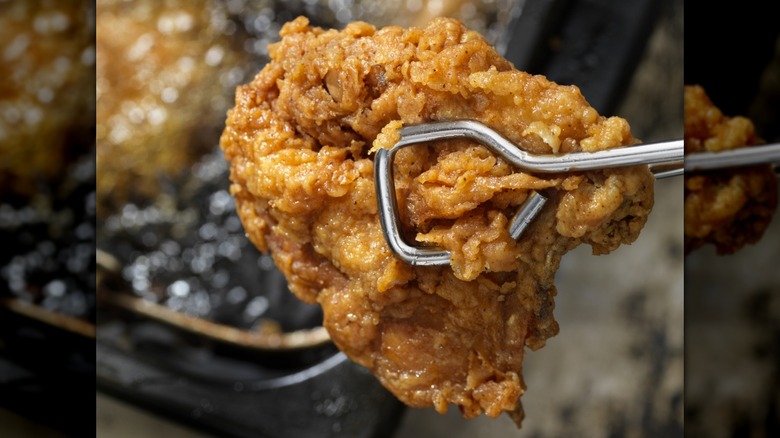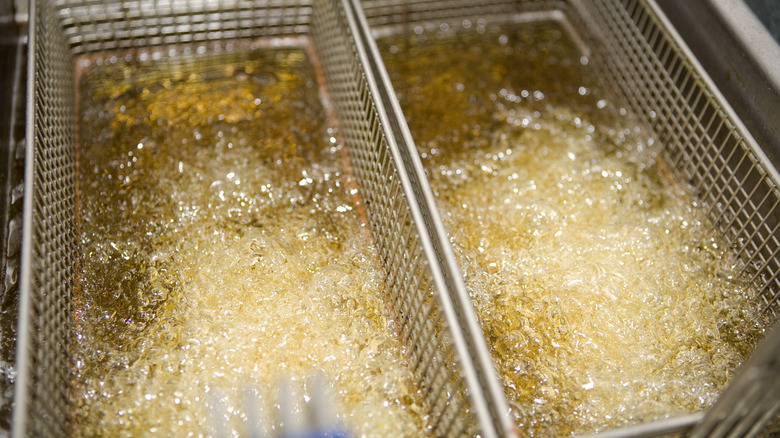What Grocery Stores Don't Want You To Know About Their Fried Chicken
If there's one thing we can all agree on, it's that fried chicken is totally delish. With so many options available to us in grocery stores these days, there's really no need to break a sweat making fried chicken on our own in the kitchen. Right? Eh ...
Though we love the convenience of grocery store fried chicken, we must admit that it isn't always what it's cracked up to be. Sometimes, there's more to food than what meets the eye, and sadly, we've found this to be very true in the world of store-bought fried chicken.
We've made the phone calls, done the research, and scanned reviews so you wouldn't have to. In this post, we'll detail what exactly you'll find in popular store-brand fried chicken, as well as standard procedures you probably never knew existed. Stick with us for all the interesting little tidbits grocery stores don't want you to know about their fried chicken.
It may have been fried in soy oil
Soybean oil is found in many processed food items these days, and that isn't typically a great thing. As you may have guessed, grocery store fried chicken is often cooked in soybean oil in tandem with other oil types. And though this oil may seem harmless, there are several risk factors attached to it, including an increased risk of compromised immune systems, fatty liver disease, diabetes, and cardiac disease.
From what we can tell, places like Walmart and Kroger use a soybean oil blend to cook up their chicken pieces. It's also possible that other grocery stores fry their chicken in soybean oil as well, although not all grocery stores choose to make their fried chicken ingredients public. You should note also that soybean oil is often cloaked as "vegetable" oil, mainly because the oil can be made up of a variety of oil types and additives put together.
If these findings bother you, it may be better to limit your exposure to foods cooked in soybean oil since repeated and long-term exposure may lead to potential health risks. And though this doesn't mean that you'll develop unwanted symptoms from occasionally eating chicken cooked in it, you could suffer health consequences down the road if you choose to consume items cooked in soybean oil regularly.
It may contain a compound found in stool softener (and other products)
Methylcellulose is one of those additives you'll likely brush over when reading an ingredient list. Like so many other additives in pre-cooked and pre-packaged food, we tend to ignore those we know nothing about — especially when many of them can be quite difficult to pronounce!
To clear up the fog surrounding this mysterious element, we want you to know that methylcellulose is an ingredient that is sometimes found in processed foods. It is often used as an emulsifying and thickening agent when added to food items like fried chicken and plant-based edibles. Still, you should know that methylcellulose, though useful in food production, is also added to other products you may be familiar with, many of which aren't so charming. Because methylcellulose is known for having a laxative-like effect when taken in high enough quantities, it is also a common ingredient in stool softeners.
Stool softener? Yep, you heard us correctly. All of this to say, it's important to know exactly what's lurking in the food you eat; you may just be unpleasantly surprised by what you discover.
Cooking procedures may vary from store to store
Following proper cooking protocol is essential for restaurants and grocery stores. After all, the health and safety of patrons should be of the utmost priority, right? Having said that, when it comes to grocery store fried chicken, we think it's important you know that procedures for getting chicken cooked up right might vary from store to store.
While we aren't privy to all of the information concerning the ins and outs of how fried chicken is made at every grocery store, we do know that there can be a lot of confusion among employees as to how long and by what process chicken meat is fried. According to some concerning Reddit posts we've come across, grocery store employees sometimes take to the internet to find out just how long fried chicken should stay in the fryer. And while this alone is alarming in its own right, it only worsens. Many answers from same-store employees vary, letting us know that things can be pretty hit or miss when having proper knowledge of standard protocol for safely cooking chicken meat.
Though these facts are indeed disparaging, there is a silver lining to this story. Though cooking procedures for fried chicken may vary from place to place, it at least seems to be a common trend for employees to take the temperature of the chicken to ensure it is safe before serving it up to the public. For that, we are most grateful.
It may contain trans fats
You may think trans fats are a thing of the past since manufacturers stopped adding them as ingredients to food long ago. But don't be deceived; this does not mean all trans fats have been eradicated from the foods you eat.
Trans fats have earned themselves a negative reputation due to the amount of health problems they cause. When consumed on an excessive and long-term basis, trans fats increase bad cholesterol levels while simultaneously lowering good cholesterol levels. This can lead to issues with the heart and can even increase your risk of stroke. With this information in mind, we were disheartened to find a whopping nine grams of trans fats in Kroger's fresh fried chicken, according to the company website. Sure, we know that fried chicken isn't exactly the healthiest grab when it comes to a choice meal, but this much trans fat in food could spell trouble when eaten regularly.
Thankfully, this isn't always the case with fried-chicken-selling retailers ... Walmart's fried chicken, though still not a health food, at least contains 0 grams of trans fat at the time of publication. Phew!
The sodium content goes above and beyond
We love fried chicken for its unmatched flavor, but what about fried chicken really makes it taste so good? We know a good blend of seasonings can go a long way, but more specifically, salt can do wonders for taking flavor above and beyond. And while we won't pretend that salt has no place in food, there's a certain point in which the use of salt becomes a little too much to the point where it actually might pose a threat to human health.
In the case of grocery store fried chicken, we were appalled to see that four ounces of Walmart deli fried chicken contains nearly half your daily value of sodium. For reference, four ounces of chicken is about one ½ cup. And while it might be difficult to determine how many pieces of fried chicken this actually equates to, we are willing to guess it isn't much. Thus, if you find yourself eating two, three, four, or more fried chicken pieces, you can easily begin to see how the sodium tally could begin to add up.
Hey, this isn't meant to scare you but to simply inform you that the sodium content in grocery store fried chicken can be really high. And because the health risks associated with eating too much sodium can be concerning, discretion when eating grocery-store fried chicken on a regular basis is strongly advised.
It's often overcooked
Are you finding that your fried chicken purchased from the grocery store is sometimes thick, hard, tough, and dry? If so, you may be dealing with grocery store fried chicken that's been overcooked.
Look, we know the benefits of cooking meat thoroughly, and trust us, we'd rather have it overdone than underdone. With that said, it doesn't make for a great flavor experience when the chicken you've purchased tastes like it's been in the fryer for too long. Complaints about Walmart's deli fried chicken and its hard and often difficult-to-chew texture have surfaced online, and it isn't pretty. Many patrons have taken to the company's website to vent their frustrations concerning their sketchy local fried chicken grocery store experience, with many citing the texture of the chicken as the source of their qualms.
Of course, overcooked fried chicken isn't always a thing, but given the fact that even standard protocol concerning how to cook chicken in grocery stores has fallen into question, we totally get how this could happen. Thus, if you really hate overcooked poultry, it might be your best bet to skip the deli fried chicken scene — apparently, it's like a box of chocolates; you never quite know what you're going to get.
It might contain some ingredients harmful to your health
We've already broken down a few of the additives contained in some grocery store fried chicken grabs, but we want you to be aware of a couple of others we've found while scanning grocery store fried chicken ingredient lists.
One of the ingredients spotted in Walmart grocery store fried chicken is propylene glycol. This ingredient is often used for preserving and improving the taste of certain foods. While this additive is generally considered safe, it should be noted that it is only such in limited amounts. Consuming this additive on a continual basis poses significant risks for people with kidney problems, as the kidneys may be unable to flush the additive from their system, thereby leading to major repercussions down the road.
Another concerning ingredient sometimes found in fried chicken is hydrogenated vegetable oil. We've already discussed how some chicken selections contain a blend of soybean oil along with other additives, but the fact that these oils are sometimes hydrogenated poses its own concerns. Hydrogenated oil may be inexpensive for manufacturers, but health concerns, including the inability to control blood sugar and an increase in inflammation, are all found to be in correlation with the overconsumption of the substance. From what we can tell, Kroger and Walmart are still using hydrogenated oils in the production of their fried chicken at the time this post was written, so please bear that in mind before taking your next bite.
The chicken isn't necessarily allergy friendly
Because grocery store fried chicken typically comes from the deli, you should know that the chicken won't necessarily be allergen-free. There is a high chance that your favorite finger-lickin' snack may come in contact with allergens, despite the fact that there may or may not be allergens listed on the ingredients list.
Publix makes this claim crystal clear by making a direct statement on its website about the possibility of cross-contamination. Other stores? Not so much. Still, Publix indicates that though its chicken may not contain all allergens on its ingredients list, its deli still uses eggs, milk, fish, peanuts, tree nuts, shellfish, soybeans, wheat, and sesame. Thus, it shouldn't be assumed that the chicken has not at some point come into contact with these allergens.
Though it may not be a big deal to some, we think it's worth reiterating, especially for people with severe allergies. If this is you, we recommend always using caution when ordering fried chicken from the grocery store deli.
The deep fryer oil may (or may not) get changed on a schedule
When it comes to how often oil used in the deli is changed, it can vary greatly from location to location. This is important because, as many of you home cooks already know, how often you change the oil plays an important role in how fried food will turn out.
How often should the oil in the deli be changed? That remains uncertain. Some Walmart employees claim the oil is changed whenever it looks dirty, while others claim to use a device that helps signal them concerning the best times to freshen things up. Another poster inserted that at their store, even if the oil looks bad, it isn't until someone who is trained to change the oil is on shift that the task is actually accomplished.
So, what does this mean for your favorite grocery store fried chicken? Put simply, it means you could run across a batch with a burned, oily, and overall disgusting taste. Thus, if you encounter grocery store fried chicken whose taste seems to match this description, know that it's likely chicken that's been cooked up in old oil. Gross!
If you don't like the chicken, it's your right to return it (most times)
While most of us know that general retail markets typically have a standard return policy, not everyone is quite so sure when it comes to perishable food. In light of all we've uncovered here about grocery store fried chicken, you may wonder if it's possible to return your fried chicken if it fails to meet your expectations.
Thankfully, most grocery stores allow you to return food items, even after opening. If you are genuinely dissatisfied with the product, simply bring in your receipt along with the food item you'd like to return for a full refund.
With that said, it's important to note that how many days you have to complete this process will vary across stores. Publix, for example, doesn't seem to give a specific "return by" date, while Walmart gives a full 90 days. Kroger offers the shortest refund window we've seen thus far, allowing only 30 days before your return period ends. Either way, know that if you end up hating your fried chicken, you have options; there's no need to stick with overcooked, undercooked, or generally unsatisfactory chicken pieces.
Your fried chicken experience may differ based on store location
As with anything food-related, you're likely to encounter both positive and negative experiences depending on the location you visit. By now, we've reviewed inconsistent practices regarding the changing of the oil and the general cooking process to ensure that the fried chicken is cooked all the way through. As a result, it's only natural to assume that some stores get it right in terms of cooking chicken while others, sadly, get it desperately wrong.
According to the fried chicken reviews we've seen, some grocery store locations dish up better-tasting and more consistently delicious fried chicken than others. We're willing to bet it has to do with better cooking practices and general management of the deli, although, on this, we can't be too certain. Still, it can be said that if you run across fried chicken that's particularly tasty from a certain Publix, Kroger, Walmart, or other fried chicken deli, you may wish to return to get the same experience; otherwise, you just might find yourself disappointed.
It may be sold several days after it's been made
Yep, you read that correctly. If the chicken you're picking up from the deli is chilled, there's the possibility that your fried chicken was cooked as many as three days ago.
Now, understand that we aren't trying to indicate that this chicken may somehow make you sick. What we are telling you, however, is that the "fresh" chicken you're picking up from the deli might not be quite as fresh as you think. This isn't hearsay, either. We called our local Walmart to get the information right from the source.
What we were told is that Walmart generally will cook up the chicken fresh before placing it in a warming element for about four hours. After four hours, the chicken's temperature will be taken to ensure it is still fit for consumption. At that point, it will be sold chilled for up to three days before it is (hopefully) thrown out. Thankfully, this protocol also falls within USDA guidelines for how long fried chicken can be stored refrigerated. At least now you know!












